
Salvete amici! It’s officially autumn and summer is over but I’m okay with that! Really I am. I had a wonderful summer this year working at Pompeii with the Pompeii Food & Drink Project, eating out at Caupona, snorkelling over a 2,000-year-old Roman villa at Baia, and eating my way down the Amalfi Coast. But seasons change, just like the wind, and with it comes natural shifts in diet and cooking preferences as well. During the winter months, we tend to move away from seafood, fruit and leafy greens and seek out heavier, carbohydrate- and protein-rich foods such as bread, pasta, root vegetables, and meat, to provide us with the extra calories that we need to survive. Personally, I love this time of year. I love getting bundled up, lighting a fire, and cooking all day long. Anything that gives me an excuse to make a huge mess in the kitchen and let the oven run all day long makes me a happy girl indeed.
This week’s article signals the kick-off of autumnal/winter cooking season for me and I think you’re going to like this recipe pairing a lot. It’s a hearty chicken dinner comprised of two Apician recipes: Parthian Chicken; and Vegetable Dinner. It fills the stomach, sticks to the ribs and is utterly delicious! In addition to this, the dinner presents beautifully and is fun to prepare. You must try it out! But before you do… let’s explore some history first:
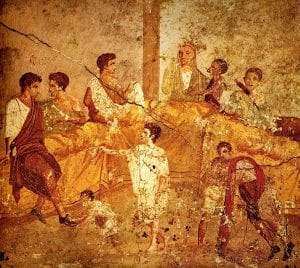
Who is Apicius? Marcus Gavius Apicius is a figure in Roman history that many love to write about. In fact, Crystal King wrote an entire novel about him, his staff, and Roman cookery, in her recently released fiction novel “Feast of Sorrow: A Novel of Ancient Rome”… and rightly so, because he was quite the character. Apicius is referred to several times in the documentary record by writers such as Athenaeus and Seneca; he was said to have been an epicure who enjoyed the excesses of life and had food and dining standards that were almost impossible to meet. Pliny the Elder says the following about Apicius: “Apicius, the most gluttonous gorger of all spendthrifts, established the view that the flamingo’s tongue has a specially fine flavor” (Pliny, Naturalis Historia, X.133 – 77 AD); and “Apicius, that very deepest whirlpool of all our epicures, has informed us that the tongue of the phœnicopterus is of the most exquisite flavour” (Pliny, Naturalis Historia, X.68 – 77 AD).
It is believed that Apicius lived in the 1st Century AD during the reign of Tiberius, but the writings and recipes (more so loose guidelines) associated with his name weren’t published until the Middle Ages and later. While the Apician recipes, titled De Re Coquinaria, that have been scrutinised and studied for hundreds of years do indeed reflect accurate Roman Imperial food preparation and ingredients, it is often suggested that the recipes may have been devised as a tribute to Apicius, or Apician gluttony, as opposed to being created by his own hand in the 1st Century AD. The recipes outlined in De Re Coquinaria are some of the most scrutinised and tested Roman recipes in the documentary record; Parthian Chicken and Vegetable Dinner are just two of them.
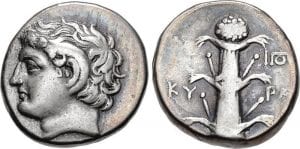
Now, if you take a moment to scan some of Apicius’ ingredients for these recipes, you’ll notice that something stands out in the Parthian Chicken recipe. There are two ingredients that are not typically used in modern cooking, and they are worth exploring further: Lovage and Laser.
Lovage (levisticum officinale/ligusticum) is a leafy, celery-like green herb that was used in Roman cooking quite frequently, if we’re to rely upon what we read in De Re Coquinaria. Many food historians believe that the seed was the main ingredient in Roman cooking as opposed to the leaves of the plant. Lovage was also used in Medieval cooking and sometimes for medicinal purposes. While it is rarely found in modern markets, some modern European recipes still call for lovage. Ajwain seed, or celery seed, are often used in modern recipe recreations to try to attain something close to what the flavour of lovage is like.
Laser (or silphium) is a fascinating spice that has an incredible history. It was a pungent, aromatic spice that was native to North Africa (Libya) and was valued so much in Mediterranean cooking in the Classical period that it was harvested to extinction by the 1st century AD. Herodotus (Book IV.168-198, 430 BC) states that the spice was once grown in a region populated by Cyrenaeans “extending from the island of Platea on the one side to the mouth of the Syrtis on the other.” To the right we see an image of the silphium plant represented on a Cyrenaean coin dated to the 2nd century BC. Grainger (2006) suggests that once the plant had been harvested to extinction, a resin from Parthia (modern day Iran) was used as a cheap and plentiful substitute. This substitute spice was, and is currently known as, asafoetida; and it can currently be found in Indian and Chinese cook shops or grocers and is also sometimes labelled as ‘Hing’ and can also be sourced on Amazon. This information gives us a pretty clear indication as to why Apicius’ Parthian Chicken recipe is titled what it is, especially knowing that the recipe likely contained asafoetida. The BBC recently published a fantastic article on the lost Mediterranean spice, Silphium, that provides additonal insight into this fascinating ancient plant and its value to those who harvested it.
There’s an experimental aspect to this recipe as well: I decided to make a sauce for the chicken using the basting broth, some old slices of tracta, and Apicius’ instructions on thickening milk-toast porridge. Binding agents are referred to in many recipes in De Re Coquinaria as amylum or amulum; what we would commonly call a ‘roux‘ nowadays. It has been suggested by many Classical food historians that tracta was more than a basic flat-bread, pastry crust or tart base; it was also used as a starch for thickening sauces, stews and porridges. Romans would use anything from egg yolks to starches to bind their sauces. De Re Coquinaria refers to the work-horse of Roman cooking, Tractum (a simple, unleavened flat-bread) as a thickener in the recipe for Milk Toast (Pultes Tractogalatae). This recipe describes making a simple, warm ‘milk and bread’ porridge using stale tractum as the thickening agent of the porridge. If you have made tracta, using the recipe published recently here on Tavola, you’ll know how durable those little cakes are once they dry. You could kill a grown man with one of them if you throw it hard enough…. They’ll also stick around longer than your in-laws if you store them in a cool, dry place. With that in mind, I decided to conduct an experiment with the tracta that I made last week: I made a sauce for the Parthian Chicken using the basting broth and some week-old tracta. You can try this experiment as well by following along with the steps at the end of the preparation segment of this article. The experiment was very interesting and the outcome was unexpected!
So with that brief preamble, let’s roll up our sleeves and cook a hearty, autumnal Roman dinner, shall we?

Apicius’ Parthian Chicken and Vegetable Dinner with a Red Wine Tracta Sauce
Parthian Chicken (Pullum Parthicum)
- 1 whole roasting chicken
- 1/2 tsp of ground pepper (10 twists of a grinder)
- 1/2 tsp caraway seed
- 1/2 tsp celery or ajwain seed
- 1/4 tsp asafoetida (or hing)
- 1 cup of red wine
- 1 cup chicken broth
- 1/2 tsp salt (optional/not in the original recipe)
Preparation
Apicius (Book VI.8) tells us to prepare Parthian Chicken the following way: “Dress the chicken carefully (clean, wash, pluck) and quarter it. Crush pepper, lovage and a little caraway moistened with broth, add wine to taste. After frying, place the chicken in an earthen dish and pour the seasoning over it, add laser and wine. Let it assimilate with the seasoning and braise the chicken to a point. When done sprinkle with pepper and serve.” (Translation from: Apicius: Cookery and Dining in Imperial Rome. Joseph Dommers Vehling, 1936)
Following Apicius’ instructions, I prepared Parthian Chicken in the following way:
Step 1. Preheat your oven to 400 F / 200 C / Gas Mark 6.

Step 2. Quarter the whole chicken the only way that works best: with a very sharp cleaver. The bones are small/weak enough that they should give under the blade very easily.
Step 3. Sear the quarters in a frying pan with olive oil. Make sure to sear both sides to crispen the skin a bit and lock in some of the moisture.
Step 4. In a saucepan or frying pan, combine the wine, chicken broth and spices and heat the liquid to a boil. While whisking the broth, let it boil for a few minutes. The idea is to burn off the alcohol in the red wine and bring the flavours of all the spices together. This is your basting broth. Note: Don’t get too overzealous in your use of asafoetida. It is strong, pungent and it will take over the entire dish if you let it. It’ll also come back on you daily for the next year if you use more than what I’ve stipulated. You’ve been warned. 🙂
Step 5. In an earthen ware (ceramic) roasting dish, place your chicken quarters with the skin facing up. Pour the spiced basting broth on top of the quarters.
Step 6. Roast the chicken quarters uncovered on 400 F / 200 C / Gas Mark 6 for 30 minutes. Baste the chicken every 10 minutes using the broth from the base of the roasting dish.
Step 7. Serve the chicken with the red wine tracta sauce alongside the Vegetable Dinner as prepared below.

Vegetable Dinner (Pulmentarium Ad Ventrem)
- 3 large leeks
- 3 large beets
- 1 tbsp grape molasses (or honey; date syrup; pomegranate syrup; fig syrup)
- 1/2 tsp cumin
- 1/2 tsp cracked black pepper (10 twists of a grinder)
- 1/2 cup vegetable broth
Preparation
Apicius (Book III.2) tells us to prepare the vegetable dinner in the following passage: “All green vegetables are suited for this purpose, very young beets and well matured leeks are parboiled; arrange them in a baking dish, grind pepper and cumin, add broth and condensed must, or anything else to sweeten them a little, heat and finish them on a slow fire, and serve.” (Translation from: Apicius: Cookery and Dining in Imperial Rome. Joseph Dommers Vehling, 1936)
Following Apicius’ instructions, I made the vegetable dinner in the following fashion:
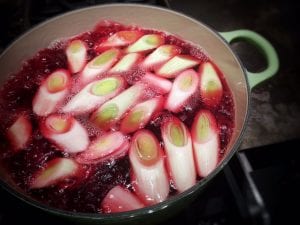
Step 1. Wash, trim and peel the beets; wash the leeks and trim off stalks and roots.
Step 2. Cut the leeks into slices approximately an inch thick. I sliced mine on an angle so that they stayed intact during the boiling process. Slice the beets into large chunks about 1/2 inch thick.
Step 3. Parboil the beets and leeks together for 5 minutes. You’ll get a nice red vegetable broth out of this process as well.
Step 4. Using a skimming spoon, remove the vegetables from the water and place them into a baking dish.
Step 5. In a bowl, add the sweetener of your choice (grape molasses, honey, date syrup, etc…) and the cumin and pepper. Add 1/2 a cup of the hot vegetable broth from parboiling the vegetables into the bowl and mix until the sweetener is dissolved fully.
Step 6. Pour the sauce onto the vegetables in the baking dish and bake uncovered on 400 F / 200 C / Gas Mark 6 for 30 minutes.
Step 7. Serve hot alongside the Parthian Chicken.
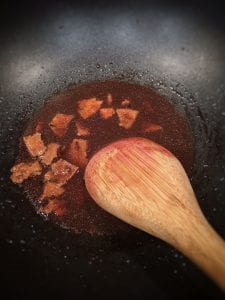
Red Wine Tracta Sauce Experiment (Optional)
- 2 tracta sections/half of a tractum disk (see Tracta Recipe)
- Parthian Chicken basting broth from the preparation/roasting of the chicken
Preparation
I started my tracta sauce experiment by leaving a few sections of the flat-cake in my bread box for a week leading up to preparing this recipe. When I thought about trying tracta as the thickener for the Parthian Chicken sauce, I asked myself: “Has Apicius had too much mulsum? Is stale tracta actually going to work as a starch thickener or will it be too hard and insoluble?” I thought that there was no possible way that the experiment could work as the tracta was quite durable and chewy when it first came out of the oven and it was even tougher in texture when it was left for a week. I am accustomed to making a supple flour and butter roux for most of my sauces so this experiment was going to be interesting. My hypothesis for the outcome was that the tracta was probably going to be too hard to break down in the broth, the tracta would remain intact, and I would not produce a thickened sauce. My hypothesis was proven to be false… but it was also proven to be true. The clever Romans win again… This is what happened:
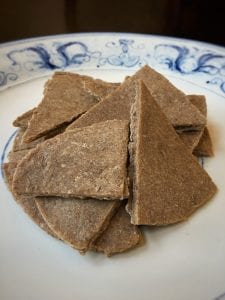
In his recipe for Pultes Tractogalatae porridge, Apicius (Book V.1) states: “Put a pint of milk and some water on the fire in a new pot; break round bread into it dry; stir well to prevent burning; add water as necessary” (Vehling, 1936). I followed these instructions using two pieces of tracta, broken into small pieces, dropped into the basting broth from the roasting pan that the chicken was roasted in. I heated the broth and the tracta on low in a pan for 15 minutes while whisking to make sure that I did not burn off all of the broth. The tracta pieces showed no signs of breaking down after 15 minutes of simmering and no amount of crushing them with my wooden spoon would soften them either. But that didn’t stop the sauce from thickening! It began to thicken at about the 15 minute mark as there must have been more than enough starch dissolving into the broth from the tracta pieces without having to break the tracta down entirely. After 20 minutes of simmering, I had a thickened red wine tracta gravy and I simply sieved the gravy, removing the tracta pieces from the sauce, before serving. See the video below to view the thickening process underway. I couldn’t have been happier to have had my hypothesis proven wrong (and right, in a strange way…). The tracta did its job as a binding agent and I had a delightful sauce to serve with my Parthian Chicken and Vegetable Dinner that was still compliant with Apicius’ methods and ingredients. In short, here are the basic steps that I took:
Step 1. Remove the chicken once it has been roasted fully and set to the side on a serving dish.
Step 2. Pour the liquid from the bottom of the roasting dish into a pan and heat on low.
Step 3. Break two sections of tracta (half of a tractum disk) and crumble the pieces into the basting broth.
Step 4. Whisk the mixture on low/low-medium for 10-15 minutes until the sauce begins to thicken and grow cloudy in colour.
Step 5. Sieve the sauce or use a skimming spoon to remove the tracta bits. Serve the sauce in a gravy boat on the side or pour it directly onto the Parthian Chicken quarters during serving.
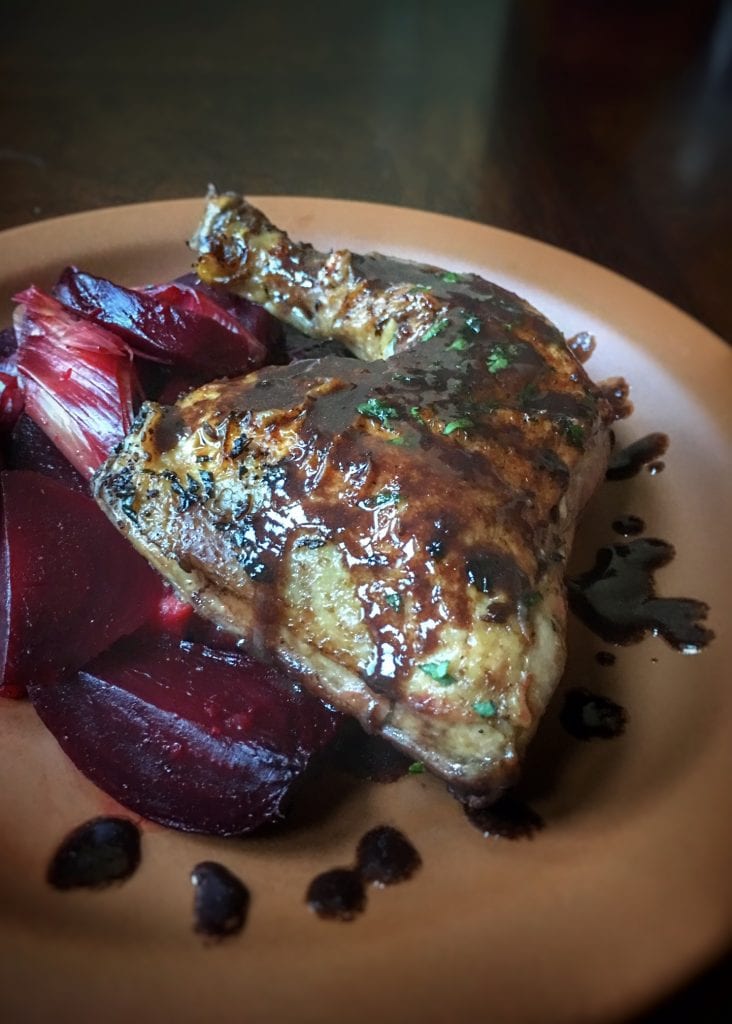
Et huc! There you have it: Parthian Chicken and Vegetable Dinner a la Apicius. This recipe was an interesting project for me, especially following the Vitellian Beans recipe that I posted last week. I am beginning to suspect a few things about our Roman ancestors and the men who documented their cooking practices. I am suspecting that Roman cooks likely salted to taste (much like we do) as they cooked their meals or after they served them. I am finding that some of the documented Roman recipes require salt (or garum) but it is often not called for. I am preparing the recipes as true to form as possible but offer an option to use salt after preparation to make it a bit more palatable to our modern taste buds. I am also suspecting that water is considered in a similar fashion as salt in some of the bread-making recipes that I am reviewing; in essence: use as needed as you go. I am beginning to notice that Romans also preferred very bold, sharp and often bitter flavours. Some of these dinner recipes tell me that Romans enjoyed cooking with wine and spices that literally hit the sinus cavity with a wallop when you’re heating them together in a broth over a flame. Ajwain, asafoetida, vinegars, wines, cumin and ground pepper pack a powerful punch… the aroma is intoxicating and it’s even more pleasurable when you taste the combined flavours after cooking. For me, it is literally like taking in the aromas and flavours of something strange, new and wonderful. The scent of red wine reducing, chicken roasting, asafoetida and ground pepper filling the air coupled with the earthy smell of boiling leeks and beets opens up an olfactory avenue for me that I have not explored fully yet and it’s delightful. I imagine many Roman kitchens smelling like this as the seasons grew colder and heartier foods were being prepared. There’s a rich, tangy, bold and slightly bitter aroma that fills the kitchen when you’re cooking these recipes. It is so present, along with the heat in the room, that you can almost smell old man Apicius through the thick of it, standing behind you judging your every move as you cook:
“Opus citius, coquus!”
“Yes, chef!”
Cena Bene and good eating to you!
Please feel free to rate and leave comments or suggestions about this recipe below.
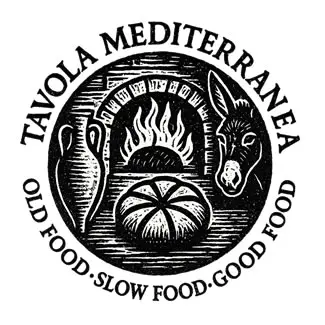








I made a short-on-ingredients version of this, with red wine, celery salt, and cracked black pepper; and some vegetable broth might have been added. Even though it wasn’t ready on time and people had been gorging on other things beforehand, they found room in their stomachs and raved. I was pretty impressed, too. I think the magic ingredient is the red wine. “They” say to use white wine with poultry, but “they” clearly don’t know everything!
Hi!
I just made this last night. It came out great! One thing that surprised me was how accessible the flavor profile was. I was almost disappointed. I wanted it to be a little weirder!
I’m very tempted to try to make it with white wine. I love white wine with chicken.
I’ve really been enjoying your site and have been getting some amazing inspiration from it!
I’m going to try to do a Roman Feat. Any suggestions?
Brian
Thanks Brian! There’s a lot to read up on if you want to plan a feast. Start with Apicius! There’s a lot of fantastic and versatile material there. The Romans knew what they were doing, by the way. If you want something weird, make some Apician luxury dishes like udder or womb or brain. That takes guts! 🙂